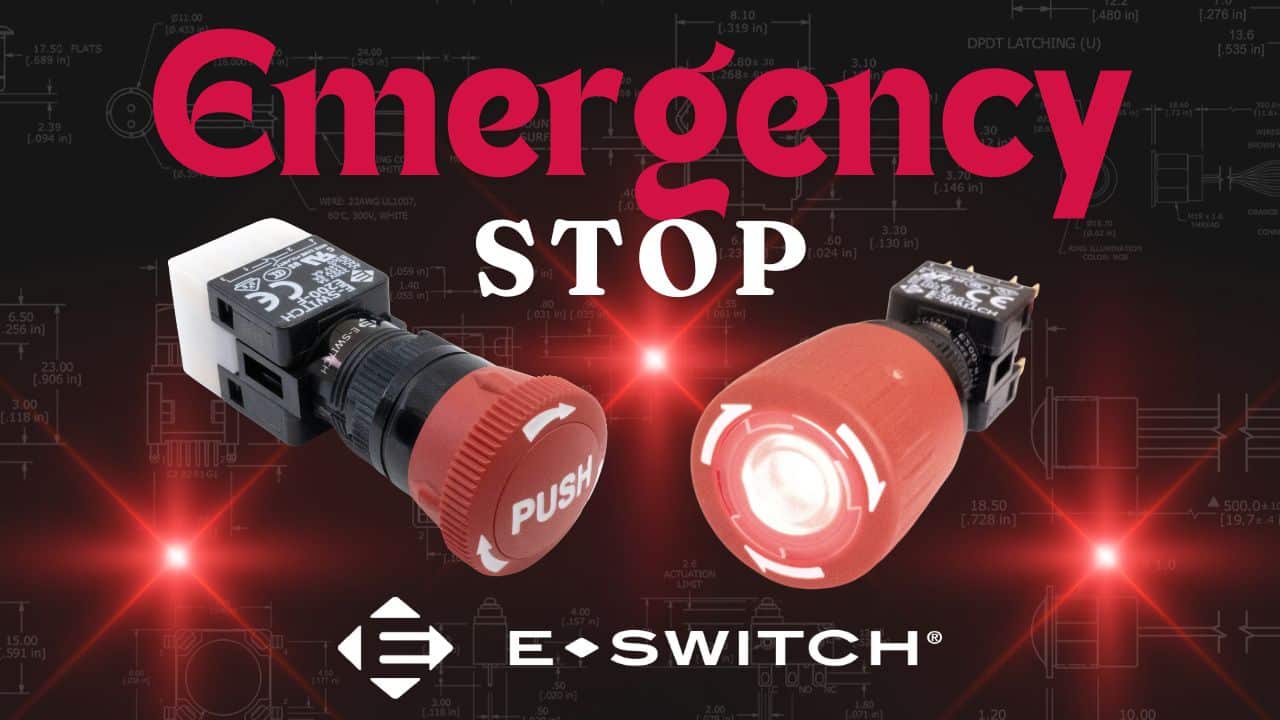What is an Emergency Stop Switch?
An emergency stop switch, also known as an E-Stop, is a safety mechanism used to quickly shut down machinery or equipment in emergency situations when standard shutdown procedures are not feasible. When activated, it immediately stops the operation of associated equipment by interrupting the power, shutting it down and preventing potential accidents, injuries and hazards. These switches are crucial for ensuring safety in various industrial and commercial settings, and many safety standards and regulations often mandate E-Stops in specific applications.
How Does an E-Stop Button Work?
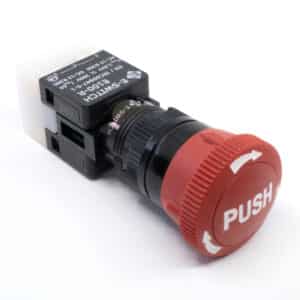
An emergency stop switch works through what could be described as a three-step process.
1. E-Stop Activation Mechanism
An emergency stop switch is typically a large (often red), easily accessible button located near machinery and equipment. When pressed, it immediately interrupts the power supply to the machinery, causing an abrupt stop. E-Stops usually are effectively pushbuttons, but some have a twist-to-release mechanism or require a key to activate.
2. E-Stop Wiring and Circuitry
The emergency stop is wired into the control circuit of the equipment and is in series with other safety devices. When the E-Stop is activated, it breaks the circuit, immediately preventing power from reaching the machine’s motor or other critical components and shutting it down.
3. E-Stop Latching Mechanism
Most emergency stops have a latching feature that, once pressed, stays in the “off” position until the switch is manually reset. Resetting often involves turning the button clockwise, a pushlock turn or even using a separate reset button.
What Are E-Stops Used For?
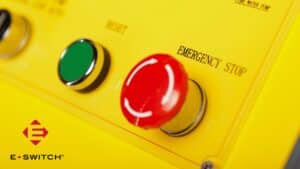
Emergency stop switches find applications across a wide range of industries and machinery types. Here are some common areas where these switches are essential.
Manufacturing and Production Lines: E-Stops are integrated into production lines to quickly stop heavy machinery such as conveyor belts, assembly lines and presses.
Transportation Systems: They’re used in control panels for transportation equipment such as trains and buses. These switches provide a rapid shutdown capability to ensure passenger safety and prevent accidents.
Robotics and Automation: In robotic work cells and automated systems, emergency stop switches are strategically placed to halt robot movements or shut down entire production lines when necessary. This prevents collisions, injuries or damage to equipment.
Food and Beverage Processing: E-Stops are crucial in food and beverage processing plants. They allow operators to quickly stop machinery in case of emergencies, ensuring food safety and preventing accidents.
Chemical Processing: Chemical plants use emergency stop switches to shut down pumps, mixers and other equipment during hazardous situations. These switches protect workers and prevent chemical spills or leaks.
Material Handling: They’re commonly found in material handling equipment such as conveyors, cranes and forklifts. Operators can instantly stop the equipment if there’s a risk to personnel or if a malfunction occurs.
Machine Tools: In metalworking and machining operations, emergency stop switches are installed on lathes, milling machines and other tools. They allow operators to halt cutting processes immediately.
Pros & Cons
Pros
#1. Quick Control: E-Stops allow for rapid control and shutdown of industrial processes.
#2. Damage Prevention: By swiftly stopping the process, these switches help prevent damage to machinery and maintain equipment integrity.
#3. Personnel Safety: Emergency stops serve as the last line of defense when other safeguards fail.
#4. Standardization: OSHA, NFPA and ANSI standards require E-Stops on industrial machinery, ensuring consistent safety practices across industries.
Cons
#1. Human Error: Operators might accidentally press the E-Stop, causing unintended shutdowns. This can be avoided with proper training and clear labeling.
#2. Reset Process: After activation, emergency stops require a manual reset. This delay can impact productivity if not managed effectively.
#3. False Positives: An E-Stop may be triggered unnecessarily due to an alert incorrectly indicating that a vulnerability is present.
E-Switch Emergency Stop Switch Products
E100 Series Pushbutton Switch
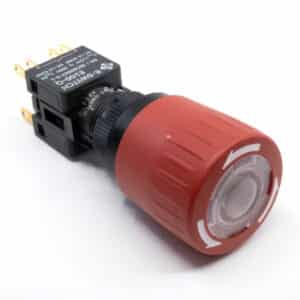
The E100 Series pushbutton switch is easy to operate with an eye-catching red actuator and multiple illumination options (LED, incandescent, neon), along with the required agency approvals. This emergency stop switch (E-Stop) requires a high actuation force (2.0 kgf) and a pushlock turn to reset, making it perfect for harsh and rugged industrial-use environments with an IP65 rating. The E100 Series has a 16mm cutout size with 5.0mm MAX panel thickness. The switch has an impressive mechanical life of 100,000 cycles minimum, an electrical life of 50,000 cycles minimum and operates from -25 to 55°C (with lamp) or -25 to 70°C (without lamp). There are three different function options: 1NC, 1NC+1NO, 1NC+1NC.
E200 Series Pushbutton Switch
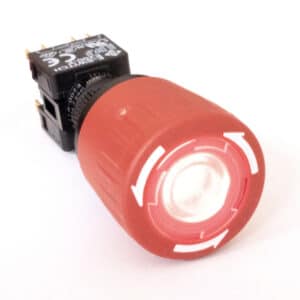
The E200 Series offers many of the same features and benefits of the E100 but with different contact arrangements — 1NO/1NC+1NO/1NC, 1NO/1NC, 2NO, 1NO — and contact ratings.
